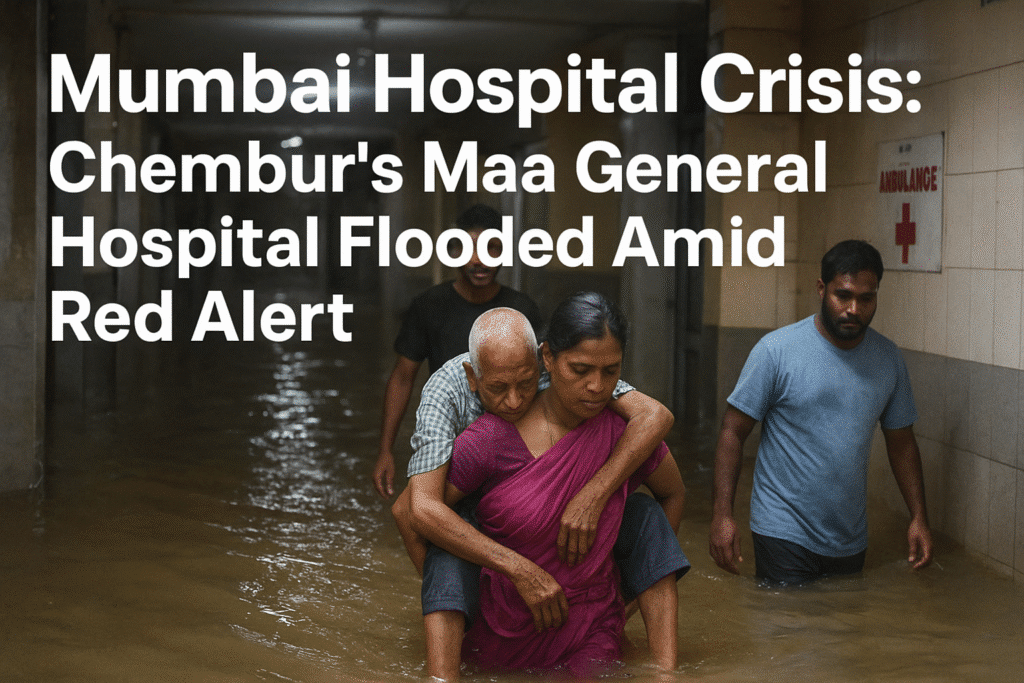Introduction
Mumbai, August 18, 2025:
The Mumbai Hospital Crisis unfolded Monday morning when parts of Maa General Hospital in Chembur became waterlogged during heavy downpours. Visuals showed relatives carrying patients across flooded corridors to access care. The Brihanmumbai Municipal Corporation (BMC) deployed pumps and emergency crews, and the situation was brought under control by evening, according to PTI reports carried by Hindustan Times.
Key Points – Mumbai Hospital Crisis
- Heavy rains on August 18, 2025 left Maa General Hospital in Chembur waterlogged, forcing families to carry patients through flooded areas.
- The BMC deployed pumps and emergency crews, restoring hospital access by evening.
- Mumbai was under a red alert as transport networks, schools, and offices were disrupted due to citywide waterlogging.
- This incident follows a similar case at KEM Hospital in May 2025, showing recurring hospital flooding during monsoons.
- Experts stress the need for tech-powered resilience in healthcare—IoT sensors, predictive analytics, and tele-monitoring could prevent future shutdowns.
- Hospital flooding poses serious risks for patients with chronic or urgent needs, including international students living in Mumbai.
- The Chembur flooding is seen as a wake-up call for integrating climate-resilient infrastructure into Mumbai’s healthcare system.
A City Under Pressure
The flooding came as Mumbai remained under a red alert, with the India Meteorological Department (IMD) warning of extremely heavy rainfall across the metropolitan region. Local trains and road networks were severely disrupted, while schools and offices struggled with staff shortages due to impassable streets.
This is not an isolated case. Earlier this monsoon, on May 26, 2025, KEM Hospital in Parel reported waterlogging inside its premises, leading to court criticism over inadequate preparedness. Such recurring incidents highlight the mounting strain on Mumbai’s healthcare infrastructure during climate-intensified monsoon seasons.
Why the Mumbai Hospital Crisis Matters
Healthcare institutions are expected to remain operational even in extreme conditions. Yet, as seen in Chembur, aging drainage systems and rising rainfall intensity expose critical hospitals to shutdown risks. For patients with chronic conditions or those requiring urgent care, even a few hours of disruption can prove life-threatening.
International students and families living in Mumbai also rely heavily on local hospitals. A crisis like this raises concerns over continuity of care, especially for those unfamiliar with alternate routes or facilities in the city.
Technology as a Future Lifeline
While the Chembur hospital response involved conventional pumping units, experts emphasize that technology-powered resilience can transform outcomes in future crises:
- Flood Sensors & IoT Monitoring – Early-warning systems can detect water levels in basements and trigger automated responses.
- Tele-Monitoring Platforms – Allow patient vitals to be shared with specialists remotely when physical access is blocked.
- Drone Deliveries – Tested in other disaster zones, drones can bring oxygen or essential supplies to rooftops if ground transport fails.
- Predictive Analytics – Machine-learning models can forecast hotspots for waterlogging, enabling pre-deployment of pumps.
These solutions are not yet standard in Mumbai hospitals, but planners and disaster-management experts argue they will soon become necessities rather than luxuries.
Practical Tips for Families and Students
- Check hospital readiness – Ask if your local facility has flood-resilience measures such as pumps or backup generators.
- Know evacuation routes – Familiarize yourself with alternate access points to hospitals.
- Keep emergency health kits – Portable oxygen bottles or power banks for medical devices can be lifesaving.
- Use official apps – BMC and IMD apps provide real-time alerts on waterlogging and hospital status.
Looking Ahead
The Chembur episode is a wake-up call for Mumbai’s healthcare system. As climate change accelerates, disaster-resilient infrastructure—from raised hospital floors to AI-enabled flood control—will be critical. Other cities such as Chennai and Pune are piloting tech-integrated flood response models, and Mumbai may soon follow.
For now, the Mumbai Hospital Crisis underscores an urgent truth: the health of millions depends not just on doctors and nurses, but on the resilience of the buildings and systems that house them.





